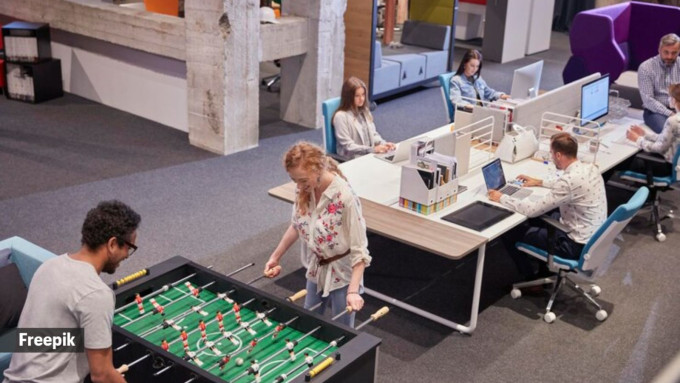Office peacocking: Can swanky spaces bring employees, accustomed to working from home, back to office?
In the wake of a major shift to remote work models, most companies today wonder how to attract employees back to the traditional office environment. At the forefront of this endeavour is ‘office peacocking,’ a trend where companies are revamping their workplaces with swanky amenities and trendy designs.
What is office peacocking?
“Office peacocking refers to making the physical office an attractive destination—renovating workspaces with appealing enhancements and extravagant amenities—to encourage employees to return to office after prolonged remote work,” said Vaishali Mehta, senior vice president, HR, Dentsu Global Services.

The appeal of office amenities
 Today, companies are ditching the mundane for modern workplaces that blend functionality with comfort, creativity, and collaboration. (Source Freepik)
Today, companies are ditching the mundane for modern workplaces that blend functionality with comfort, creativity, and collaboration. (Source Freepik)
A recent Glassdoor survey found that 79 per cent of employees value perks and amenities more than a pay raise. “Office peacocking can create a more inviting atmosphere, temporarily boost employee morale, and enhance engagement. It’s also a great way to attract talent in today’s competitive job market,” Mehta said.
A study by the American Psychological Association highlighted the potential benefit of fostering in-person connections. With 46 per cent of remote workers reporting feelings of isolation, enhanced office spaces could help companies cultivate a sense of camaraderie and team spirit.
The productivity debate
However, not everyone is convinced. Amit Prasad, founder and CEO of SatNav Technologies, pointed out that “these concepts might be more attractive for companies with large workforces. Small-scale businesses might just need employees back full-time or find replacements for those who resist.”
While office peacocking might make the office environment more attractive, its impact on productivity is still debated, as employees have found that remote work increases their productivity with fewer interruptions and a more flexible schedule.
“To an extent, attractive office spaces and amenities can encourage office visits, but companies should not necessitate daily attendance, especially at the expense of the flexibility and autonomy that hybrid work provides,” Shivangi Sharma, a digital content producer, shared with indianexpress.com.
A study by Stanford University found that remote workers are 13 per cent more productive than their in-office counterparts. This raises the question: Is the effort and expense of office peacocking worthwhile if employees thrive at home?
 While some may dismiss coffee badging as a passing fad, it represents a subtle resistance to rigid return-to-office directives. (Source Freepik)
While some may dismiss coffee badging as a passing fad, it represents a subtle resistance to rigid return-to-office directives. (Source Freepik)
This has resulted in a new trend of ‘coffee badging‘, which further complicates the issue as it is being seen as a form of employee resistance against mandatory return-to-office policies. It refers to occasional visits to the office solely for coffee breaks, giving an impression they are actively working on-site.
A senior technical analyst at Adobe shared, “Office amenities can be distracting, leading to decreased productivity. Socialising during breaks cuts into work time, lowering output despite fixed office hours. I prefer working from home to minimise distractions and optimise my time.”
The way ahead
Despite the growing popularity of office peacocking, experts warn of its potential downsides. Pressuring employees to return to the office full-time could lead to burnout and decreased job satisfaction.
A McKinsey survey underscored this point, revealing 52 per cent of employees prefer a hybrid model. “More than just attractive workspaces, companies need to cultivate a culture of belonging. Employees who feel valued and enjoy positive relationships with colleagues are more likely to be engaged and motivated, regardless of location. That’s the real key to encouraging employees to return to the office,” said Mehta.
Hence, as the future of work continues to evolve, companies that prioritise employee well-being, offer flexible work models, and create work environments that foster both productivity and connection will likely have the upper hand in attracting and retaining top talent.
Disclaimer: The copyright of this article belongs to the original author. Reposting this article is solely for the purpose of information dissemination and does not constitute any investment advice. If there is any infringement, please contact us immediately. We will make corrections or deletions as necessary. Thank you.
